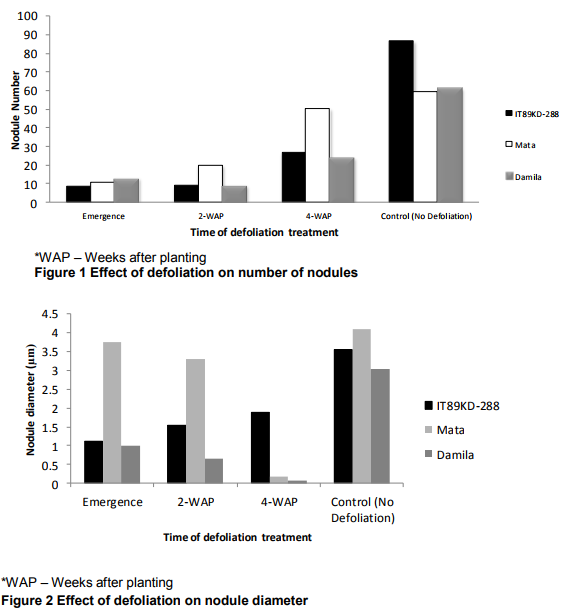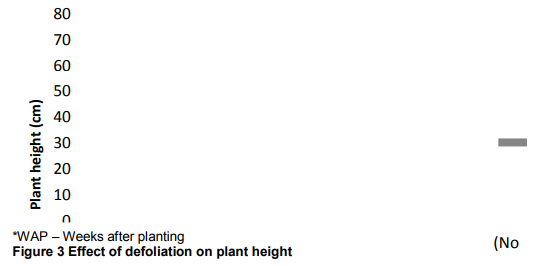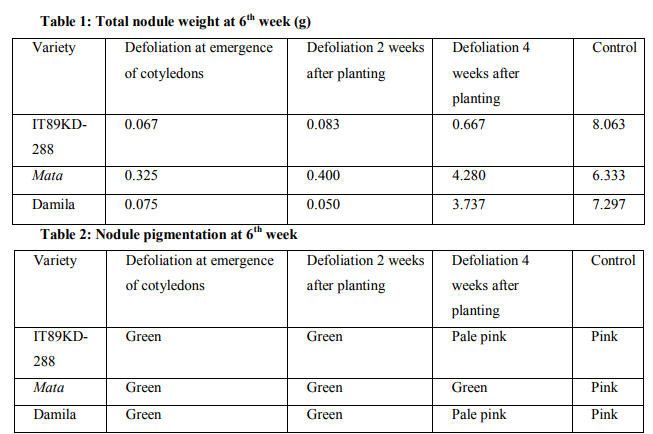IJCRR - 4(17), September, 2012
Pages: 95-102
Date of Publication: 14-Sep-2012
Print Article
Download XML Download PDF
EFFECT OF EARLY DEFOLIATION ON THE NODULATION AND SOME AGRONOMIC TRAITS OF SOME SELECTED COWPEA (VIGNA UNGUICULATA L. WALP)
Author: Ogundele O. E. and Awosanya A. O.
Category: General Sciences
Abstract:This study investigated the effect of defoliation at emergence of cotyledons, 2 weeks and 4 weeks after planting on the number of nodules, nodule diameter, total nodule weight, nodule efficiency, root length and plant height of two improved varieties and one local variety of Vigna unguiculata (L.) Walp. efoliation treatments were carried out in triplicates using the CRD. Plants were raised in pots and data collected after 6 weeks. This study simulated early defoliation of the crop as evidenced in pest attack, disease infection and/or grazinganim als and significantly reduced nodule number (P< 0.001), nodule diameter (P< 0.002) and total nodule weight (P< 0.001). Change in nodule pigmentation was also observed. The effect of reduction in nodule characters was observed to culminate in a corresponding decrease in agronomic traits such as plant height (P< 0.001) and root length (P< 0.001). To reduce the effect of early defoliation on cowpea, farmers should plan the crop?s sowing so that its early growth
stage would escape the season of dominance of its major defoliators.
Keywords: agronomic, defoliation, cotyledons, nodulation, Vigna unguiculata
Full Text:
INTRODUCTION
The problem of maintaining soil fertility in time past had led to the use of manure and fertilizers. However, these methods were constrained by erosion which leads to the washing away of the nutrients in the top soil. Alternative methods have since been used by planting legumes such as cowpea to maintain soil fertility and at the same time prevent soil erosion. Crop farmers now focus on legumes for the aforementioned benefits they attract and their ability to form association with bacteria that can fix nitrogen to the soil. Consequently, productivity is improved in terms of quality and quantity. Cowpea, a staple food with high protein, mineral and vitamin content is also valued for improving soil fertility through the formation of root nodules for nitrogen fixation. It plays an important role in agriculture by providing soil nitrogen. The symbiosis can help relieve the requirement for added nitrogenous fertilizer of other crops that are intercropped with cowpea. The legume is known for its symbiotic association with Rhizobium bacteria enabling it to fix atmospheric nitrogen (Laity et al., 2003). Bacteria of the genus Rhizobium play a very important part in agriculture by inducing nitrogen-fixing nodules on the roots of legumes such as cowpea. However, the growth of cowpea is limited by numerous biotic (diseases, insects and other pests) and abiotic factors that can cause serious devastation (Rahman et al., 2008). Several foliage defoliators, including insect pests have been reported to cause severe defoliation of cowpea. Aphids (Aphis craccivora) attack cowpea especially at the early vegetative stage (IITA, 2000) while a considerable number of insects belonging to Acrididae and Lepidopteran larvae have been reported feeding on cowpea leaves, “skeletonizing” and sometimes defoliating the entire plant. Other foliage defoliators of cowpea belong to the family Chrysomelidae (Allen et al., 1996). Several studies in crop defoliation have received attention in the last four decades using various crops. Studies have also been carried out to determine the effects of defoliation at the different growth stages on yields of crops, as it simulates pests and disease damages. Some studies (DeBeer, 1983; Schneiter et al.,1987; Schneiter and Johnson, 1994) described an interaction between the severity of damage (percentage defoliation) and the growth stage at which this occur. Some of the earlier studies on defoliation of cowpea were particular about defoliation at the different growth stages (Rahman et al., 2008) and situations peculiar to America and Europe. There is probably little or no information on cowpea defoliation at the vegetative stage in Nigeria where the crop is largely grown. Defoliation as it may be caused by pests and disease conditions affects the growth of the entire plant. Perhaps nodulation of the crop is also affected by the defoliation thereby having a great impact on nitrogen fixation and consequently crop productivity. This study was therefore conducted to determine the effects of defoliation at the vegetative stage of growth on the nodulation of some selected varieties of cowpea Vigna unguiculata (L.) Walp. in the South-Western part of Nigeria.
MATERIALS AND METHODS
Cowpea Varieties
Two improved varieties of Vigna unguiculata (L.) Walp. (IT89KD-288 and Damila) from IITA and a local variety (Mata) in Nigeria were used for the research.
Preparation of Experimental Pots
The experiment was a completely randomised design with 36 experimental pots arranged in greenhouse. The experiment was carried out at the botanical garden of the biological sciences department in Tai Solarin University of Education, Ijagun, Nigeria between March and April. The experimental pots were perforated at the base to allow for proper drainage. Loamy soil from the botanical garden was used.
Planting
Three hand-picked healthy seeds were planted in each pot and later thinned to one after germination. Cultural practices such as weed control were also carried out regularly.
Treatments
There were 4 treatments including the control for each variety. The treatments were:
- Defoliation immediately after emergence of cotyledons;
- Defoliation 2 weeks after planting;
- Defoliation 4 weeks after planting;
- No defoliation (control) Each treatment was done in triplicates.
Data Collection
Data were collected 6 weeks after planting. In determining the number of nodules, each pot was carefully emptied and the soil on the root was gently washed with water. Root nodules were physically counted with the aid of hand lens. The nodules present on the roots of each plant were collected and weighed with electric weighing balance to obtain the total nodule weight. Nodule diameter was measured with the aid of a micrometer screw gauge. Nodule efficiency was determined by examining the root nodules of each plant to check for the presence of the reddish-pink pigment (leghaemoglobin), which indicates a functional or efficient nodule. Plant height and root length were measured using meter rule. Dry mass of shoot was measured using an electric weighing balance after shoots had been oven-dried at 60OC for 72hours.
Data Analysis
Analysis of data was done using ANOVA with Genstat® statistical package.
RESULTS
The effect of defoliation on the number of nodules was highly significant in the three varieties used (P<0.001). Similar results were obtained for total nodule weight, nodule diameter, root length and plant height with P<0.001, P<0.002, P<0.001, P<0.001 respectively.In figure 1, earliest defoliation treatments significantly inhibited nodule formation and consequently reduced nodule numbers. Similarly, Defoliation 2 weeks after planting and 4 weeks after planting still had significant reduction on the nodule numbers but not as pronounced as the earliest defoliation.
Defoliation immediately after emergence of cotyledons, at week 2 and week 4 reduced nodule diameter relatively only in IT89KD-288. Mata and Damila showed significant reduction of nodule diameter only in those defoliated at week 4 (Figure 2).???????
Figure 3 shows that defoliation immediately after emergence of cotyledons reduced plant height >50% in all the three varieties. However, week 4 treatments mildly reduced height of IT89KD-288 and Mata which are the erect type.


The total nodule weight was significantly reduced in all three varieties when treatment was applied immediately after emergence of cotyledons and 2 weeks after planting. However total nodule weights were severely reduced in IT89KD-288 when treatments were applied 4 weeks after planting (Table 1).

Table 2 shows that nodules of the plants defoliated after emergence of cotyledons and 2 weeks after planting had green pigment indicating lack of leghaemoglobin. In week 4 treatments, only nodules of the two improved varieties showed traces of leghaemoglobin with pale pink pigmentation.
There was a relative reduction in root length in treatments with earlier defoliations. Only the root length of Mata, the local variety was slightly reduced in week 4 treatment (Table 3).

DISCUSSION
Early defoliation had negative effect on nodule characters (such as nodule numbers, nodule diameter, total nodule weight and nodule pigmentation), root length and plant height. However, the severity of the effect depends on the time of defoliation. Earliest form of defoliation (immediately after emergence of cotyledons) produced the most severe reduction in nodulation, nodule characters and other traits studied. Defoliation at week 4 produced severe and mild reduction on all the traits studied. The result of this study is in agreement with the observations of Muro et al.,(2001) that showed that the effect of defoliation depends on foliar surface area eliminated and on growth periods at which this takes place. The significant reduction in nodule characters as a result of defoliation treatments suggests that there is a relationship between foliar surface area and nodulation process in cowpea. Loss or reduction of foliage parts hinders photosynthesis. Perhaps, the cotyledons and leaves supply food and some necessary precursors for the initiation of nodulation. Anonymous (2009) also reported similar observations using soybean seedlings and clover seedlings when it noted that the product of photosynthesis and cotyledons supply essential factors for nodulation and that cotyledon removal soon after germination delays, reduces or prevents infection of root hairs for nodulation. Foliage removal immediately after emergence caused stunting in the plants while the removal of the foliage parts at week 2 and week 4 only caused slight reduction in plant height when compared with the control. The stunting may not be unconnected with the inhibition of gibberellins production which stimulates growth in apices of young plants and their inability to synthesize enough carbohydrate through photosynthesis, which is necessary for plant growth and development. This is corroborated by the findings of Mondal et al., (1978) and Selter et a.,(1980) that suggested that defoliation alters hormone balance, starch, sugar, protein and chlorophyll concentration of plants. Change in nodule pigmentation observed in defoliated plants suggest that photosynthesis and nitrogen fixation are inter-related processes. The greenish content of nodules of defoliated plants at the time of data collection points to the fact that the nodules, though formed, were not only reduced in number and diameter, but also non-functional and inefficient. This observation is supported by Hartwig and Nosberger (1994) that defoliation causes dramatic decrease in nitrogenase activity.
CONCLUSION AND RECOMMENDATION
Cowpea helps to increase the nitrogen pool of the soil, improving its fertility and enhancing agricultural productivity. Early defoliation of the crop as it may be caused by pest attack, disease infection and/or grazing animals has been revealed by this study and others to severely reduce nodule characters such as nodule numbers, nodule diameter, total nodule weight and nodule efficiency. The effect of this reduction in nodule characters was observed to culminate in a corresponding decrease in other traits such as plant height and root length in similar manner. This in turn tends to undermine the potential of cowpea to serve as Africa?s cheapest source of soil nitrate. To reduce or eliminate the effect of defoliation on cowpea, farmers are advised to plan the crop?s sowing such that its early growth stage should escape the season of dominance of its major defoliators. Further research works should be conducted to discover other ways of preventing foliage loss apart from the use of pesticides and breeding for varieties with higher leaf surface area. Finally, cowpea breeders should make attempt in their future work to breed varieties that are tolerant to pest attack and diseaseresistant. This may also help to limit the effect of early defoliation on the nodulation of the crop.
Acknowledgement
IITA for providing the two improved varieties of cowpea used for this research
References:
1. Allen D J, Ampofo J K O, Wortman C S (1996). Pests, diseases and Nutritional disorders of the common bean in Africa. A field guide. The Netherlands, CTA, 132pp.
2. Anonymous 2009. Rhizobium and Legume Root Nodulation.Http://www.microbiologyprocedur e.com/rhizobium-and-legume-rootnodulation/temperature-and-light.html
3. DeBeer J P (1983) Hail damage simulation by leaf area removal at different growth stage of sunflower. Gewasproduksie. 12: 110-112.
4. Hartwig U A and Nosberger J (1994). Plant and soil 16(1): 109-114.
5. IITA, 2000. Crops and farming systems. Http://www.iita.org/crop/cowpea.htm.
6. Laity F, Diouf D and Fall M A (2003). Genetic diversity in cowpea varieties
7. determined by ARA and RAPD techniques. Afr. J. Biotechnol. 2: 48-50.
8. Mondal M H, Brun W A, Brenner M L (1978). Effect of sink removal on photosynthesis and senescence in leaves of soya beans plants. Plant physiology. 61: 394-397.
9. Muro J, Irigoyen I, Militino A F, Lamsfus C (2001). Defoliation effects on sunflower yield reduction. Agronomy Journal. 93: 634-637.
10. Rahman S A, Ibrahim U and Ajayi F A (2008). Effect of defoliation at different growth stages on yield and profitability of cowpea (Vigna unguiculata L. Walp.) E. J. Env. Agric. & Food Chem. 7(9): 3248-325.
11. Schneiter A A, Johnson B L (1994). Response of sunflower plants of physical injury. Can. J. Plant Science. 74: 763-766.
12. Schneiter A A, Jones J M, Hammond J J (1987). Simulated hail research in sunflower defoliation. Agronomy Journal. 79: 431-434.
13. Selter T L, Brun W A, Brenner M L (1980). Effect of obstructed translocation of leaf abiscic acid and associated stomatal closure and photosynthesis decline. Plant physiol. 65: 1111-1115.
14. Shibbles R, Secor J, Ford D M (1987). Carbon assimilation and metabolism.Agronomy. 16: 535-588.
|






 This work is licensed under a Creative Commons Attribution-NonCommercial 4.0 International License
This work is licensed under a Creative Commons Attribution-NonCommercial 4.0 International License